News
We May Lose Seawater in 600 Million Years - Seawater is Sucked into the Earth Updated in January 2018
Not many people would question the existence of sea on earth. Earth was born about 4.6 billion years ago. By 1 billion years ago, the ocean was formed. Creatures born in the sea came up to live on land. The ocean has always been with the earth from such ancient times. However, "common sense" that the earth would always come with the ocean may turn into a preconceived notion. According to the paper released by Kohei Hatakeyama (Hiroshima University Graduate School of Science doctoral course), and Professor Ikuo Katayama,* seawater is being sucked into the earth at a faster pace than expected. With simple calculation, seawater may disappear from earth in 600 million years. *Hiroshima University, Graduate School of Science, Department of Earth and Planetary Systems
The water in the ocean circulates around the globe in different forms. Seawater evaporates and comes down as rain. Rain falling on land becomes a river and pours into the ocean. Including the deep ocean current traveling beneath us, it takes some thousands of years for these waters to go around the earth once.
Other forms of water take much longer to go around. Hatakeyama and his team focuses on such huge-scale circulation of water. The whole surface of the earth is can be divided into about ten gigantic rock plates. They push against each other or sway sideways. On the continental plate where our lands sit on, heavier oceanic plates stealthily slide underneath. For instance, under the plate where Japan is located, the Pacific Plate and Philippines Sea Plate come sliding in from east.
Such oceanic plates contain seawater because its upper side is the seabed. As these plates dive into inner-earth with seawater, oceanic waters would be reduced or drained. Oceanic plates take tens of millions of years to slide downwards, so the rate of water to travel around is on a much greater scale. Through a new experiment, Hatakeyama's team reconsidered how oceanic plates contain water.
The oceanic plate is made of two layers of different nature. The upper side in contact with seawater is called the "crust" which has a thickness of about 5 kilometers. The bottom part is the top of the "mantle" which spreads down deeper into the earh-core. The point where oceanic plate enter into the continental plate constitutes a deep groove in the seabed. This is called a "trench." Earthquakes occur frequently around trenches. One type of “fault” (large crack on the surface of earth) that can cause earthquakes, is called an "outer rise fault".
An outer rise fault is a crack on the ocean floor, located some distance away from a trench. From this crack, seawater seeps into the bottom of the ocean. It was already known that the crust contained water, because it is in in contact with seawater. But from recent seismic wave observations, it was found that the mantle with cracks also contain seawater. However, the percentage of seawater in the upper mantle remained clear.
When the underground mantle absorbs water, it turns in to a rock called “serpentinite.” Serpentinites sometimes appear on the earth's surface and seabed due to crustal movements from the past. Hatakeyama and his colleagues used experiments to find out how much water the mantle contains by using serpentinite collected from the Boso Peninsula in Chiba Prefecture. Boso Peninsula is located near the Mariana Trench.
Consequently, they found that the mantle in the oceanic plate could contain about 2.3% of seawater. This is comparable to approximately 2.1% of moisture contained in the crust. The thickness of the crust is about 5 kilometers, whereas the depth of water penetration into the mantle is about 7 kilometers. At a spot where the oceanic plate slides under the continental plate, the crust would contain much seawater as the mantle below. In other words, seawater sinking to the bottom of the sea is sucked into the interior of the earth at a speed twice as fast than we estimated before. The total quantity of such sinking seawater would amount to 2.3 billion tons per year. If oceanic waters are lost every year at this rate, our seawaters would be lost in 600 million years.
From oceanic plates submerged under the continent, some water would be squeezed out and discharged on land through rising magma. The amount of discharged water, however is far less than the amount of water sucked into the earth’s interior. Theory suggesting the disappearance of seawater had already been recognized before, but Hatakeyama and his team made it even more convincing and realistic.

Photos courtesy of Japan Science and Technology Agency







